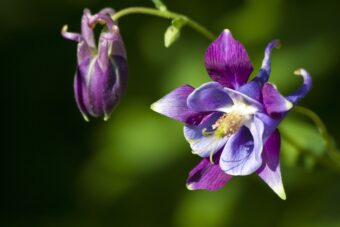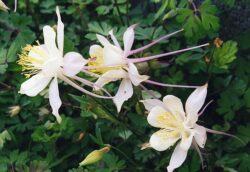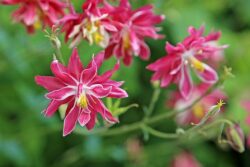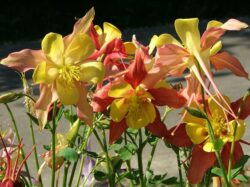In this article, we will discover how to grow the old-fashion but a firm favourite of Aquilegia in containers. As you can imagine this colourful cottage garden favourite makes an ideal plant to grow in containers, where it has the common name of either Granny’s Bonnet or Columbine. In general, they are easy to grow and naturalise as part of a container display.

The nectar-rich flowers are attractive to wildlife and so worth growing. It is a dainty perennial with grey-green ferny-like leaves and on top of these short-spurred flowers appear that come in shades of blue, white, yellow, purple and pink. There are many varieties available where the blooms can be single to double and some even have an unusual spurn to them. The flowers are often nodding, bell-shaped and look delicate and are often produced in late spring to late summer. This makes a difference from the blue and white flowers that were often seen in the past.
Find out how to grow Aquilegias in containers in this article.
GROWING AQUILEGIA IN CONTAINERS
You have two options concerning Aquilegia as you can either grow them from seeds or you can plant garden-ready plants.
GROWING FROM SEED
After you have purchased seeds available from your local seed supplier or online shops, you can start to plant them 2 to 3 months before the final frost date. First, fill a seed tray with seed compost and water it until the growing media is moist. Sprinkle the seeds finely on top and lightly cover them with a thin layer of sieved compost. Do not cover too deeply as they will not germinate, cover the seed tray with a propagator lid and place the tray near a window that gets some shade, keep the compost moist at all times and after 20 to 30 days the seeds will have germinated.

When the Aquilegia starts to produce its true leaves and before the long taproot gets too big, you will need to prick them put and transplant them individually to 7.5cm pots full of multipurpose compost. Allow them to grow on and in Mid-May start to harden the young plants off before planting in late May.
At this stage, shop-bought plants and home-reared plants can be treated in exactly the same way. You can either grow them individually in containers or in a group in a large container. Choose a container that will suit the plant and be well-proportioned, Whatever you choose, make sure it has plenty of holes in them. To aid with drainage add a 1cm layer of gravel at the bottom of the container and atop of this add any multipurpose compost to 5cm below the rim.
Aquilegias are not fussy about what type of soil it is grown in. You can place the plants 30cm apart for them to be at their best. Dig a hole in the compost slightly bigger than the root ball it came in the original container. Place the plant in the hole, so that the top of the root ball is at the same level as the surface of the compost. Backfill with the growing media, using more compost if any gaps remain. Firm the plant in and water well.
GROWING CONDITIONS FROM AQUILEGIA
It can be grown in full sun but will do better in light shade. You will need to water frequently and especially when 5cm below the top of the surface of the compost feels dry to the touch. Water well until it emerges from the drainage holes. To help conserve moisture you can mulch around the plant.

In early spring, give an annual feed with a slow-release fertilizer to give it a boost for the growing season. In early summer before the flowers appear you can provide an additional boost by adding high-potash liquid fertilizer to help produce better blooms.
Once it has finished flowering, you will need to deadhead spent blooms. Cut down the stems of the border varieties once flowering is over.
PESTS AND DISEASES
Luckily they suffer little in the way of pests and diseases. The only problem you are likely to account is leaf miner damage. All you have to do is remove affected leaves as insecticides will be ineffective.
If you get other pests such as aphids, blast them off with jets of water or use a systemic insecticide if it is really bad.
VARIETIES OF AQUILEGIA TO GROW
Many of the columbines you will find are based on Aquilegia vulgaris but most are based on the name rather than species.

‘Magpie’ has near black and white flowers, whilst ‘Niva’, ‘White Star’ or ‘William Guinness’ have all white flowers. ‘Nora Barlow’ has double flowers, whilst ‘McKana Hybrids’ produces tall flowers that are bicoloured and come in shades of yellow, blue and white.
For near-black double flowers grow Aquilegia vulgaris var. stellata ‘Black Barlow’.
For a yellow and white variety grow ‘Sunshine’ or ‘Yellow Star’. If red is your thing then the red and white varieties called ‘Danish Dwarf’, ‘Red Dwarf’ or ‘Crimson Star’ should be for you and it is compact too. A similar variety but has larger flowers is ‘Red Star’.
For true multicoloured varieties grow Aquilegia caerulea ‘Mrs Scott-Elliott’ or Aquilegia x hybrida ‘Crown Jewels Mixed’. For something a little more flamboyant that has purple or yellow flowers grow Aquilegia flabellata var. pumila ‘Rosea’ or Aquilegia viridiflora ‘Chocolate Soldier’ that has elegant dark purple flowers.
A true double variety with green flowers is Aquilegia x hybrida ‘Green Apples’. For a purple, you will need to get Aquilegia x hybrid ‘Royal purple’.
For blue and white flowers, you cannot go wrong with ‘Dragonfly’ or ‘Blue Star’.
As you can see you do have plenty of choices.
CONCLUSIONS
In this article, we have discussed how to grow Aquilegia in containers to give as much colour to the late spring container display. As you can see, you have plenty of choices and no shortage of how many can be grown.
They tend to be disease resistant and easy to look after if you get the watering right. The good news is that if you grow plenty of varieties, there is a chance that they will cross-pollinate with each other, creating unique new varieties.
A plant that has earnt its place in anybody’s garden. If you have any questions or comments that you wish to make on growing Aquilegia in containers, please do so in the comment box below.
